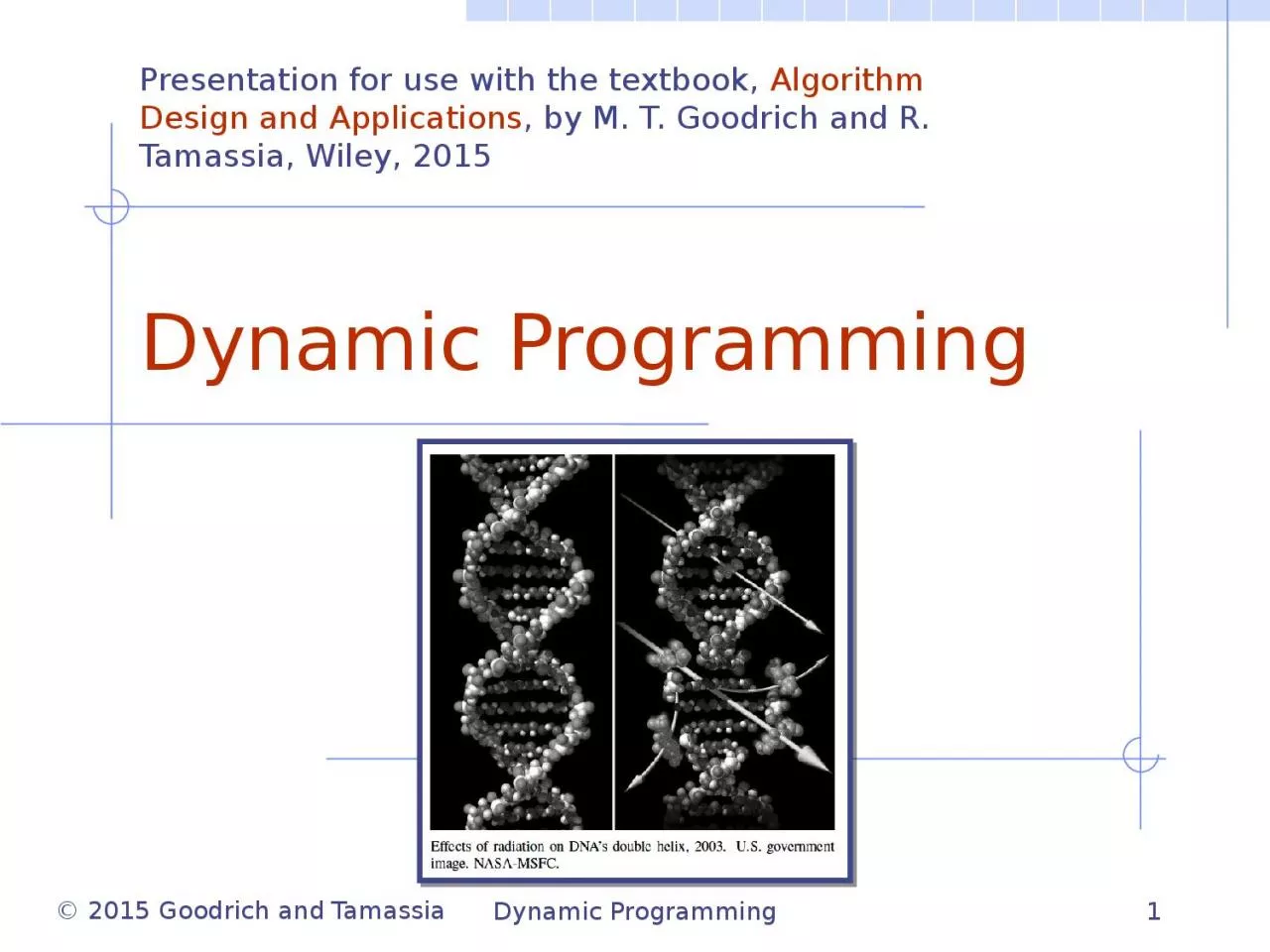

Presentation for use with the textbook Algorithm Design and Applications by M T Goodrich and R Tamassia Wiley 2015 Application DNA Sequence Alignment DNA sequences can be viewed as strings of ID: 1001781
Download Presentation The PPT/PDF document "Dynamic Programming 1 Dynamic Programmin..." is the property of its rightful owner. Permission is granted to download and print the materials on this web site for personal, non-commercial use only, and to display it on your personal computer provided you do not modify the materials and that you retain all copyright notices contained in the materials. By downloading content from our website, you accept the terms of this agreement.
1. Dynamic Programming1Dynamic ProgrammingPresentation for use with the textbook, Algorithm Design and Applications, by M. T. Goodrich and R. Tamassia, Wiley, 2015
2. Application: DNA Sequence AlignmentDNA sequences can be viewed as strings of A, C, G, and T characters, which represent nucleotides.Finding the similarities between two DNA sequences is an important computation performed in bioinformatics. For instance, when comparing the DNA of different organisms, such alignments can highlight the locations where those organisms have identical DNA patterns.Dynamic Programming2
3. Application: DNA Sequence AlignmentFinding the best alignment between two DNA strings involves minimizing the number of changes to convert one string to the other.A brute-force search would take exponential time, but we can do much better using dynamic programming.Dynamic Programming3
4. Dynamic Programming4Warm-up: Matrix Chain-ProductsDynamic Programming is a general algorithm design paradigm.Rather than give the general structure, let us first give a motivating example:Matrix Chain-ProductsReview: Matrix Multiplication.C = A*BA is d × e and B is e × fO(def ) timeACBddfefeiji,j
5. Dynamic Programming5Matrix Chain-ProductsMatrix Chain-Product:Compute A=A0*A1*…*An-1Ai is di × di+1Problem: How to parenthesize?ExampleB is 3 × 100C is 100 × 5D is 5 × 5(B*C)*D takes 1500 + 75 = 1575 opsB*(C*D) takes 1500 + 2500 = 4000 ops
6. Dynamic Programming6An Enumeration ApproachMatrix Chain-Product Alg.:Try all possible ways to parenthesize A=A0*A1*…*An-1Calculate number of ops for each onePick the one that is bestRunning time:The number of paranethesizations is equal to the number of binary trees with n nodesThis is exponential!It is called the Catalan number, and it is almost 4n.This is a terrible algorithm!
7. Dynamic Programming7A Greedy ApproachIdea #1: repeatedly select the product that uses (up) the most operations.Counter-example: A is 10 × 5B is 5 × 10C is 10 × 5D is 5 × 10Greedy idea #1 gives (A*B)*(C*D), which takes 500+1000+500 = 2000 opsA*((B*C)*D) takes 500+250+250 = 1000 ops
8. Dynamic Programming8Another Greedy ApproachIdea #2: repeatedly select the product that uses the fewest operations.Counter-example: A is 101 × 11B is 11 × 9C is 9 × 100D is 100 × 99Greedy idea #2 gives A*((B*C)*D)), which takes 109989+9900+108900=228789 ops(A*B)*(C*D) takes 9999+89991+89100=189090 opsThe greedy approach is not giving us the optimal value.
9. Dynamic Programming9A “Recursive” ApproachDefine subproblems:Find the best parenthesization of Ai*Ai+1*…*Aj.Let Ni,j denote the number of operations done by this subproblem.The optimal solution for the whole problem is N0,n-1.Subproblem optimality: The optimal solution can be defined in terms of optimal subproblemsThere has to be a final multiplication (root of the expression tree) for the optimal solution. Say, the final multiply is at index i: (A0*…*Ai)*(Ai+1*…*An-1).Then the optimal solution N0,n-1 is the sum of two optimal subproblems, N0,i and Ni+1,n-1 plus the time for the last multiply. If the global optimum did not have these optimal subproblems, we could define an even better “optimal” solution.
10. Dynamic Programming10A Characterizing EquationThe global optimal has to be defined in terms of optimal subproblems, depending on where the final multiply is at.Let us consider all possible places for that final multiply:Recall that Ai is a di × di+1 dimensional matrix.So, a characterizing equation for Ni,j is the following:Note that subproblems are not independent--the subproblems overlap.
11. Dynamic Programming11A Dynamic Programming AlgorithmSince subproblems overlap, we don’t use recursion.Instead, we construct optimal subproblems “bottom-up.” Ni,i’s are easy, so start with themThen do length 2,3,… subproblems, and so on.The running time is O(n3)Algorithm matrixChain(S): Input: sequence S of n matrices to be multiplied Output: number of operations in an optimal paranethization of Sfor i 1 to n-1 do Ni,i 0 for b 1 to n-1 do for i 0 to n-b-1 do j i+b Ni,j +infinity for k i to j-1 do Ni,j min{Ni,j , Ni,k +Nk+1,j +di dk+1 dj+1}
12. Dynamic Programming12answerN01012…n-1…n-1jiA Dynamic Programming Algorithm VisualizationThe bottom-up construction fills in the N array by diagonalsNi,j gets values from pervious entries in i-th row and j-th column Filling in each entry in the N table takes O(n) time.Total run time: O(n3)Getting actual parenthesization can be done by remembering “k” for each N entry
13. Dynamic Programming13The General Dynamic Programming TechniqueApplies to a problem that at first seems to require a lot of time (possibly exponential), provided we have:Simple subproblems: the subproblems can be defined in terms of a few variables, such as j, k, l, m, and so on.Subproblem optimality: the global optimum value can be defined in terms of optimal subproblemsSubproblem overlap: the subproblems are not independent, but instead they overlap (hence, should be constructed bottom-up).